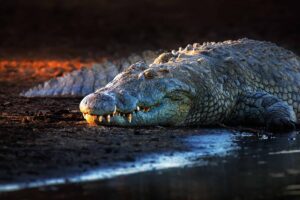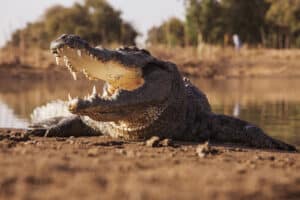Crocodiles are sometimes called “living fossils,” looking much the same as they did millions of years ago. The first crocodiles were from the Triassic period about 240 million years ago. Crocodiles were around before dinosaurs but came from the same crown group, Archosaurs. This group included crocodiles, birds, pterosaurs, and dinosaurs. Fossils found around the world help us piece together what some of the ancient crocodiles looked and behaved like. Let’s take a look at the complete list of ancient crocodiles!

Ancient crocodiles were alive at the same time as dinosaurs. Some were nearly 40 feet long.
©Elenarts/Shutterstock.com
Aegisuchus: 100.5-93.9 million years ago, large flat head, nicknamed the “Shieldhead,” fossils found in Morrocco.
Allodaposuchus: 86.3-66 million years ago, very similar to modern-day crocodiles, 9 feet long, fossils found in France, Romania, and Spain.
Amphicotylus milesi: 150 million years ago, semi-aquatic, very similar to modern-day crocodiles, fossils found in the Morrison Formation in Wyoming.
Anatosuchus: 113-110.5 million years ago, nicknamed the “Duck Croc,” small crocodile around 2 feet long, has a bill-like snout and extended nose, fossils found in Niger.
Angistorhinus: 237-208.5 million years ago, nicknamed the “Hook snout,” long skinny snout, larger croc about 26 feet long, fossils found in Arizona, New Mexico, Texas, Wyoming.
Armadillosuchus: 94-84 million years ago, nicknamed the “Armadillo crocodile,” thick bony plates on its wide back, 6 feet long, fossils found in the Bauru Basin of Brazil.
Baurusuchus: 93.9-89.8 million years ago, a genus of land crocodiles, eyes and nostrils on the side of the skull, 11-13 feet long, fossils found in Brazil.
Brachychampsa: 93.5-63.3 million years ago, one of the earliest alligatoroids, 8-10 feet long, fossils found in Montana’s Hell Creek Formation, New Mexico, Colorado, North Dakota, and South Dakota.
Carnufex: 237-228 million years ago, nicknamed the “Carolina Butcher,” walked upright on two legs, 9 feet long, thought to be a major predator before the time of the dinosaurs, fossils found in North Carolina.
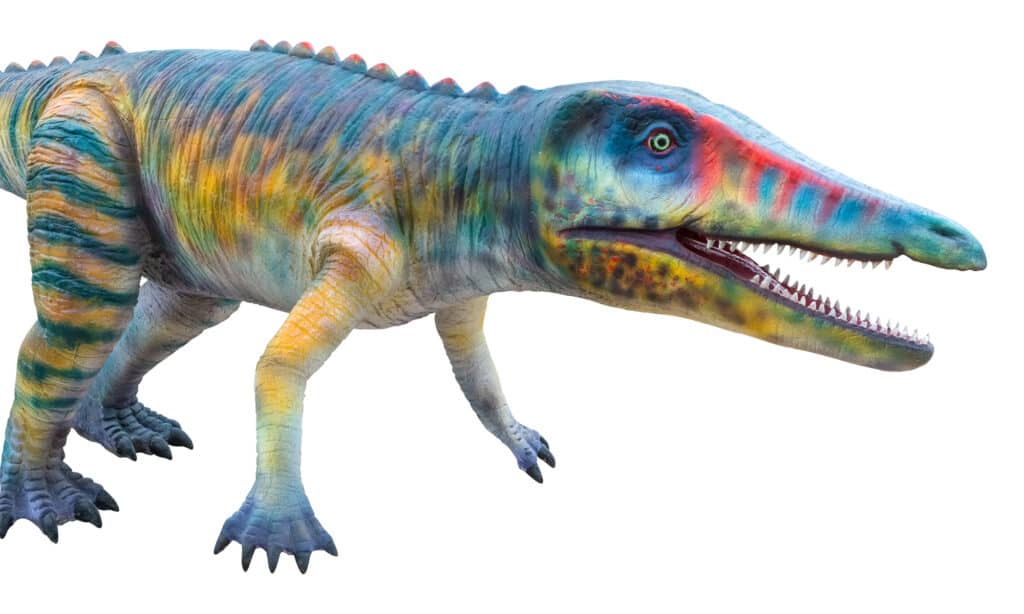
Carnufex is an
extinct
genus of
crocodylomorph suchianfrom the Late Triassic.
©YuRi Photolife/Shutterstock.com
Champsosaurus: 93.9-58.8 million years ago, a larger and smaller species with the larger being 10 feet and the smaller closer to 5, looked more like a modern-day gharial with a long skinny snout, fossils found in the US, Canada, and France, some fossils are almost complete.
Crocodylus checchiai: 23-5.3 million years ago, fossils found in Libya and Kenya. After recently re-examining one skull, scientists propose that ancient crocodiles originated in Australia and its surrounding islands and traveled through Africa to reach the Americas.
Dakosaurus: 163.5-139.8 million years ago, marine croc with a tall deep skull, 13-16 feet long, nicknamed the “Biter Lizard,” fossils found in North America, South America, Europe, and Russia.
Deinosuchus: 82-70 million years ago, one of the largest ever, nicknamed “terrible crocodile,” 26-39 feet long and 5,500-11,000 lbs., fossils found in USA and Mexico.
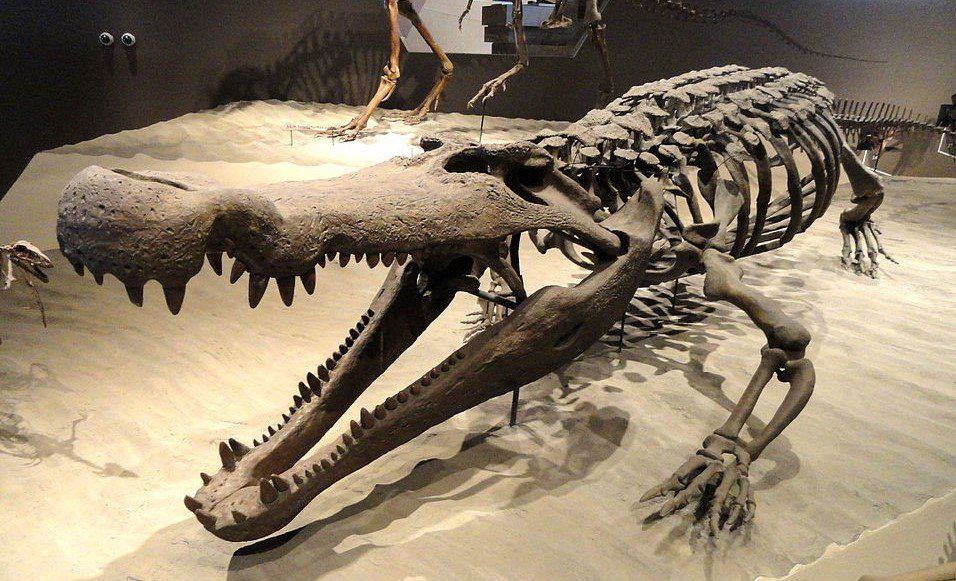
is part of the crocodylians, the group that includes modern
alligators
, crocodiles, and gharials.
©Daderot / CC0 1.0 – License
Diplocynodon: 83.5-70.6 million years ago, marine crocodile, nicknamed “double dog tooth” due to two large fang-like teeth, 3-4 feet long, fossils found in many European countries as well as the New Jersey, Virginia, and Wyoming.
Doswellia: 237-208.5 million years ago, small skinny crocodile, close to the ground, 6 feet long, fossils found in Texas, Utah, New Mexico, and Virginia.
Erpetosuchus: 237-201.3 million years ago, one of the oldest crocodiles, walked similar to a greyhound, almost two feet long, smaller crocodile, fossils found in Scottland and Connecticut.
Euthecodon: 23-2.58 million years ago, large crocodile with a very long snout, the snout was 10 meters long (32+feet!), thick-bodied tail, only had four teeth, fossils found in Egypt and Ethiopia.
Gryposuchus: 23 -5.3 million years ago, looked like a giant modern-day gharial, 10 meters long (32 feet), fossils found in Argentina, Brazil, Colombia, Peru, and Venezuela.
Goniopholis: 163.5-145 million years ago, looked much like the modern-day crocodile, about 6.5 feet long, fossils found in Europe and Africa.
Gracilisuchus: 242-237 million years ago, nicknamed the “Graceful crocodile,” tiny croc that walked on its hind legs, only 2 feet long including the tail, fossils found in Argentina.
Geosaurus: 163.5-100.5 million years ago, a genus of short-snouted marine crocodiles, around 10 feet long, fossils found in France and Germany.
Isisfordia: 100.5-93.9 million years ago, a small Australian crocodile, 3 feet long, looked similar to modern-day croc, fossils found in Australia.
Kaprosuchus: 100-95 million years ago, nicknamed “boar crocodile,” similar in size to modern Saltwater crocodiles, 20 feet long and 2000 lbs., fossils found in Africa.
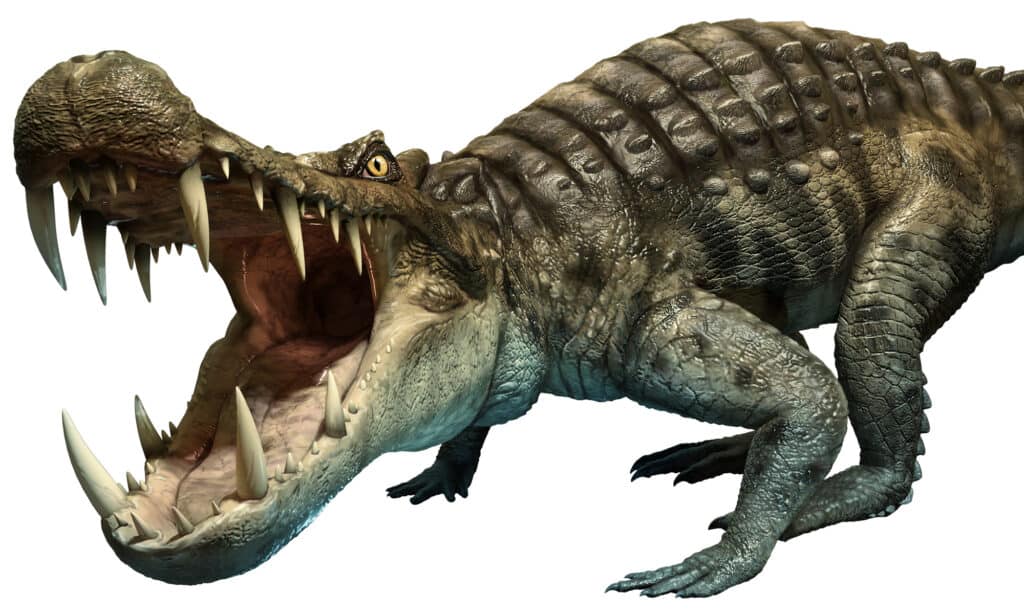
Kaprosuchus can have lengths of up to 20 feet.
©Warpaint/Shutterstock.com
Mourasuchus: 23-5.3 million years ago, one of the largest crocodiles ever, up to 39 feet long, with a duck-like bill and pelican-like pouch, fossils found in South America, a unique specimen on our list of ancient crocodiles.
Mahajangasuchus: 100.5-66 million years ago, estimated to be 16 feet long based on the skull size, fossils found in Madagascar.
Metriorhynchus: 163.5-145 million years ago, a marine crocodile with a fluke tail like a dolphin, one of the better-known prehistoric crocodiles, around 10 feet long, with many fossils from Europe.
Mystriosuchus: 228-196.5 million years ago, skinny snout like modern-day gharials, about 13 feet long, lived in the rivers and streams of Europe, fossils found in Germany and Italy.
Neptunidraco: 170.3-168.3 million years ago, marine crocodile with a dolphin-like tail, about 13 feet long, fossils found in Italy.
Notosuchus: 85 million years ago, one of the first crocodiles thought to be entirely terrestrial (living on land only), about 5 feet long, fossils found in Argentina, Patagonia.
Purussaurus: 23 million to 5.3 million years ago, one of the largest crocodiles ever, up to 41 feet in length and weighing up to 18,000 lbs., apex predator of the Miocene epoch, thought to have the strongest bite force of any animal in the world, fossils found in South America belongs on our list of ancient crocodiles for sure!

Purussaurus is one of the largest crocodiles ever, with some estimated to get up to 41 feet in length!
©Nobu Tamura (http://spinops.blogspot.com) / CC BY 3.0 – License
Poposaur: 237-201.3 million years ago, one of the first ancient crocodiles, walked on their hind legs, about 13 feet long, including their T-rex-like tail, fossils found in multiple locations like Arizona, Texas, and Wyoming.
Phytosaur: 229-200 million years ago, nicknamed “plant lizard,” semi-aquatic gharial-like crocodile, long skinny snout with pronounced sharp front teeth, about 10 feet long, fossils found in North America, Europe, and India.
Pakasuchus: 125-100.5 million years ago, the crocodile that tried to be a mammal, had teeth similar to mammals and a dog-like nose at the end of its snout, long legs but small only about 20 inches long, nickname “Cat crocodile,” fossils found in South Africa and Tanzania.
Pholidosaurus: 145-100.5 million years ago, long-snouted marine crocodile, fossils found in Germany
Protosuchus: 201.3-145 million years ago, one of the first crocodiles, small only about 3 feet long, short snout, fossils found in Arizona, Canada, and South Africa.
Quinkana: 24 million to 40,000 years ago, a large Australian, long-legged, tall crocodile that was about 5 feet tall at the back, up to 20 feet long, land crocodile, fossils found in Queensland, Australia.
Rhamposuchus: 23 million to 5.3 million years ago, one of the largest crocodiles, looked like the modern-day false gharial, 26-26 feet long, fossils found in India.
Rutiodon: 237-208.5 million years ago, very similar look to modern-day crocodiles, 8-26 feet long, fossils found in Germany, Mexico, Switzerland, as well as multiple states in the US.
Sarcosuchus: 110 million years ago, nicknamed the “SuperCroc,” large crocodile estimated at 29-40 feet long, full-bodied and heavy tail, fossils found in Algeria, Brazil, Morocco, and Niger.

The Sarcosuchus imperator (flesh-eating crocodile), nicknamed Supercroc, has an estimated body length of 40 feet.
©HombreDHojalata / CC BY-SA 3.0 – License
Stomatosuchus: 100.5-93.9 million years ago, a large crocodile but toothless on the bottom, had a pelican-like pouch under its snout, scientists are curious about what it ate, about 32 feet long. Fossils were found in Egypt.
Smilosuchus: 237-201.3 million years ago, two species of different sizes, both had long legs and a long snout, the smaller was around 16 feet, the larger was around 22 feet, fossils found in Arizona.
Terrestrisuchus: 208.5-201.3 million years ago, tiny crocodile only about 30 inches long, land crocodile, longer legs, probably agile, fossils found in England and Wales, definitely belongs on our list of ancient crocodiles.
Did Deinosuchus eat T. Rex?
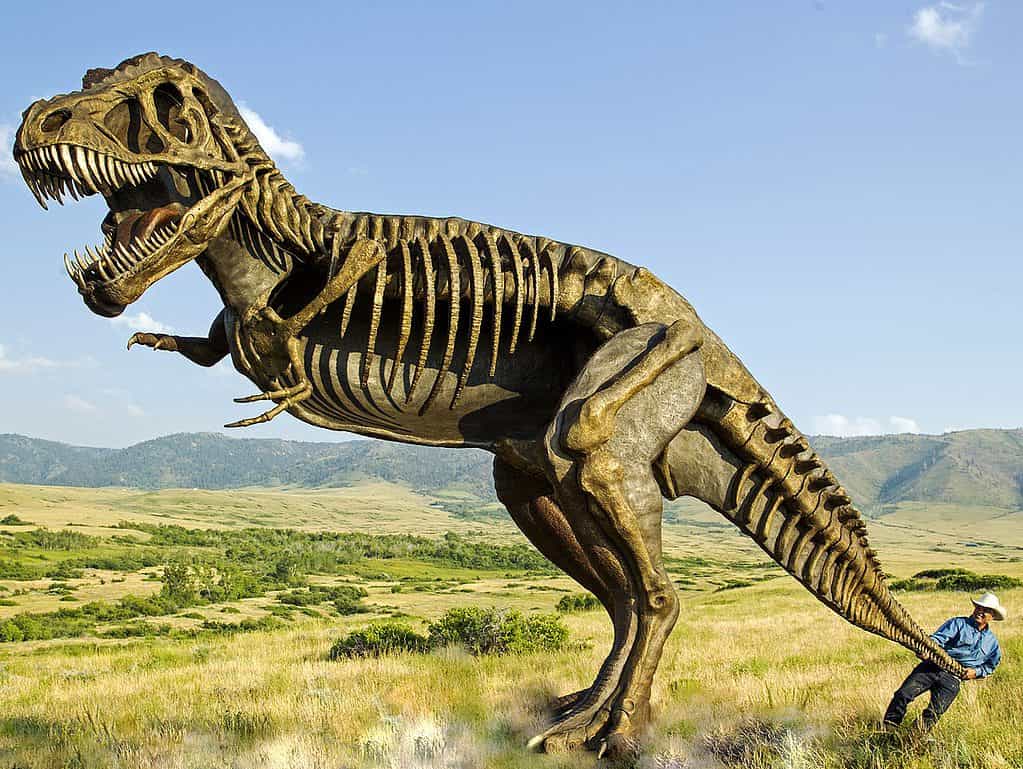
may have ruled the Earth, but it did so millions of years after
Deinosuchus.
©Chris Navarro / CC BY-SA 4.0via, Wikimedia Commons – License
As the largest prehistoric alligators that ever lived, it is quite possible that this creature may have been able to eat a Tyrannosaurus Rex, as well as other large dinosaurs. However, the actuality that this occurred is non-existent due to one factor – they didn’t exist at the same time. Tyrannosaurus Rex, or T. Rex, didn’t arrive on the scene until about 68 million years ago, while Deinosuchus existed more than 72 million years ago.
There were more than 4 million years separating them, and while scientists are not exactly sure what happened to deinosuchus, they do know that they were long gone by the time of the dinosaur mass extinction. Should this ancient crocodile have remained, its sheer size, coupled with its massively strong jaws, would have certainly made a meal out of the mighty T. Rex.
The photo featured at the top of this post is © HombreDHojalata / CC BY-SA 3.0 – License / Original
Thank you for reading! Have some feedback for us? Contact the AZ Animals editorial team.




